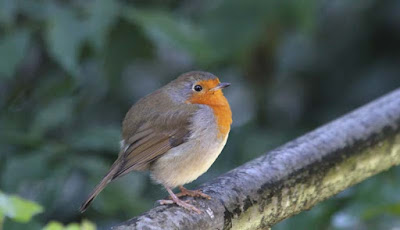I
took a different approach on the 5th, with stronger southeast winds
forecast netting wasn’t really an option so I began my morning early on Castle
Hill.
Walking through town from my Flat it was evident that a few Thrushes were
arriving with small numbers of Redwing
and Song Thrush heard and seen
passing overhead.
Once on Castle, it was immediately obvious there were more migrants on there
that there was yesterday, only six Goldcrest were logged but I had counted 20 within 5 minutes, the same applied
to Robin.
I slowly snaked my way down the sheltered north side adding more Robin, Goldcrest, Song Thrush
and Redwing as well as 2 Chiffchaff.
After an hour or so of being on there I reached the plateau on the north side,
it’s always worth spending a bit of time in this area as today ultimately
proved.
After a rather quiet half an hour with a couple of Brambling and Thrushes in off plus a rather unexpected Whimbrel heading south, what proved to
be a male Blackcap caught my eye.
I tried to get close for a photograph or two before it flew across the path and
into the bushes on the north side.
It was whilst following that Blackcap that I caught sight of something far more
interesting, a Phyllosc with a really obvious, at the time white looking,
supercillium! Mantle tones seemed all brown with no hint of greens at all.
I was sure it was a Radde’s/Dusky type.
Shortly
after a quick phone call to Steve, who was elsewhere on Castle, to alert him it
flew the opposite directing to the Blackcap and dropped into the Rosebay
Willowherb, in there it soon started calling, a short almost double ‘chrtchrt’
giving it an almost rattle feel to it – a RADDE’S
WARBLER!
It eventually showed and confirmed its identity. A few distant record shots were fired off before it dived into the Blackthorn out of sight and unfortunately promptly shut up.
 |
| Some record shots of the Radde's |
The rest of the afternoon was spent adding to the generally low totals of common migrants, trying to relocate the Radde’s (it was heard calling on two occasions from deep within brambles, as well as being seen briefly before lunchtime), and hoping the Albatross from further south would head north (it didn’t).
End of day totals from Castle were 40 Redwing, 34 Song Thrush, 15 Blackbird, 60 Robin, 3 Blackcap, 1 Garden Warbler, 4 Chiffchaff, 2 Yellow-browed Warbler, 45 Goldcrest, 3 Brambling and 1 Siskin.
 |
| Goldcrest |
 |
| Goldcrest |
 |
| A fresh in Song Thrush behind the Marine Drive wall |
 |
| Also behind the wall, one of many fresh in Robins |
The next day was fairly quiet, I began at Long Nab before moving south and
finishing up ion Castle Hill. Species wise of was the same, with slightly lower
numbers, and apparently very little coming in off the sea.
Highlights were a Black-tailed Godwit
on Johnson’s Marsh and Yellow-browed
Warblers at Long Nab and Castle Hill.




































